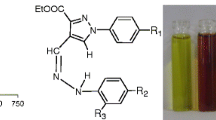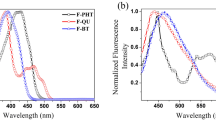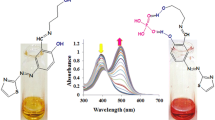Abstract
In this paper, a new ferrocenylimidazole compound L was designed and synthesized. L could selectively sense a fluoride anion among test anions such as F−, AcO−, Cl−, Br−, I− and HSO4 −, accompanied by obvious color or electrochemical changes. The detection limit in a DMSO solution was calculated as 5.94 × 10−6 M−1. From the Uv–vis, NMR and electrochemical titrations, it was indicated that L and fluoride anions formed a 1:1 complex with hydrogen bonding and anion–π interactions.
Similar content being viewed by others
Avoid common mistakes on your manuscript.
Introduction
The design of chemical probes for biologically important anions such as fluoride is of increasing interest due to their important roles in the field of chemistry [1–4], biology [5–7], and the environment, etc. [8–10]. Among different outputs in physical signals of ion recognition events, the colorimetric and the electrochemical signals are especially attractive, since they allow for the so-called “naked-eye” detection, and they are qualified with fast response and high selectivity as well as inexpensive installations [11–14].
It is well known that NH units such as amides, (thio)ureas, ammonium, and imidazole could serve as hydrogen bonding sites for anions in diluted solutions [15–18]. The −NO2 group with a π system has been used extensively to construct colorimetric receptors [19]. Ferrocenyl-based compounds are considered to be ideal anion sensing materials due to their stability, favorable electrochemical property, and reaction activity [20, 21]. In this paper, a new ferrocenyl-imidazole-based compound L with a large conjugated π system which had the ability to selectively sense fluoride anions was designed and synthesized, and the sensing events were accompanied by obvious colorimetric and electrochemical changes.
Materials and methods
Reagents and solutions
Organic solvents were analytical pure grade and obtained from Sinopharm Chemical Reagent. NaNO2, ferrocene, 4-nitro-1,2-phenylenediamine, [Bu4N]F, [Bu4N]AcO, [Bu4N]Cl, [Bu4N]Br, and [Bu4N]I were obtained from Darui Chemistry.
Instrumentation conditions
1HNMR spectra were recorded on a Mercuryplus instrument at 500 Hz. Uv–vis experiments were measured on a Perkin-Elmer Lambda 35-UV/VIS spectrometer. The CV measurements of the solution were carried out with a CHI-600A electrochemical analyzer (CH Instruments, Austin, TX, USA) in a three-electrode cell. The working electrodes were a Au electrode, a Ag-wire counter electrode and a saturated calomel reference electrode. The supporting electrolyte was 0.1 M Bu4NPF6, with a scan rate of 20 mV/S at 25 °C.
Synthesis of receptor L
Ferrocenecarboxaldehyde (1 mmol, 214 mg) and 4-nitro-1,2-phenylenediamine (1 mmol, 153 mg) were refluxed in ethanol for 24 h, then the mixture was concentrated and purified by column chromatography (SiO2: CH2Cl2/CH3OH = 20: 1) to yield L. 1HNMR (500 MHz, DMSO-d6): 4.14 (5H, s), 4.56 (3H, s),5.10 (2H, s), 7.64–7.66 (1H, d, J = 9 Hz), 8.06–8.08 (1H, d, J = 9 Hz), 8.36 (1H, s). ESI: (L + H)+=348.04.
Results and discussion
Selectivity of L toward anions
The synthesis procedure of compound L can be seen in Scheme 1. From an overall considerations of solubility and polarity, titration experiments of L toward anions such as F−, AcO−, Cl−, Br−, I− and HSO4 − were carried out. From Fig. 1, compound L showed two peaks at 288 and 334 nm, while with the addition of the fluoride anion (20 equiv. With the maximum value), the peak at 334 nm disappeared and a new peak at 414 nm appeared and was greatly enhanced, while AcO− triggered much weaker changes such as that of F−. Other anions, such as Cl−, Br−, I− and HSO4 −, did not cause any spectral or color changes. The above results indicated that L showed a higher selective recognition toward F− compared with other anions.
Uv–vis titrations of L toward F− and AcO−
As seen in Fig. 2a, upon the addition of fluoride anions from 0 to 20 equiv., two new peaks at 300 and 416 nm appeared and increased. Two good isobestic points at 312 and 364 nm also revealed that the receptor L and fluoride formed stable complexes. The method of continuous variation (job plot) was used to prove a 1:1 stoichiometry of L with fluoride (Fig. 3). The binding constant of L with F- was calculated as 4.1 × 104 M−1, and the detection limit in DMSO solution was calculated as 5.94 × 10−6 M. The sensing process was also accompanied by obvious color changes from pale yellow to yellow, which allowed for the naked-eye detection of fluoride (Fig. 4).
As a interfering ion, AcO- triggered very weaker spectral changes compared with those of fluoride. As seen in Fig. 5, upon the addition of AcO−, the absorption bands of the complexes from 306 to 362 nm decreased, while bands from 362 to 511 nm increased, which was similar but much weaker than those of fluoride, indicating the weak host–guest interaction of L with AcO−.
The chemosensor L was also able to sense F− with obvious electrochemical signal output due to the introduction of the Fc group and the −NH of the imidazole group. As seen in Fig. 6, the two signals at 0.648 and 1.350 V which were assigned to the oxidation peaks of −NH and Fc groups decreased regularly upon the addition of fluoride anions, whereas the corresponding redox peaks at −0.418 and −0.034 increased gradually.
1HNMR titrations were also performed to precisely study the selective binding events of L toward F−. Figure 7, shows that, when treated with 10 equiv. of fluoride, the signals of C–H2 of the benzyl group shifted from 8.08 to 7.94 ppm and the C–H1 and C–H3 also exhibited upfield shift and broadening, which revealed that a strong anion–π interaction existed between F− and the nitro-benzyl group [22–24]. The Hs of Fc group also showed upfield shift and broadening just like that of the benzyl group. The above results indicated that the deprotonation process occurred with the addition of excessive flouride anions, which triggered the obvious color changes of the L solution.
Conclusion
In summary, a new kind of Fc-based chemosensor L for selectively recognizing a fluoride anion was designed and synthesized. The sensing events were accompanied by color and electrochemical changes, which allowed for dual detection of the fluoride anion. The binding mechanism was studied through Uv–vis, electrochemical and 1HNMR titrations, and it was found that both hydrogen bonding and deprotonation process played important roles in the recognition event.
References
R. Martinez-Mannez, F. Sancenon, Chem. Rev. 4419, 103 (2003)
M. Cametti, K. Rissanen, Chem. Commun. 2809, 20 (2009)
M. Yousuf, N. Ahmed, B. Shirinfar et al., Org. Lett. 2150, 16 (2014)
X.D. Yu, Y.J. Li, Y.B. Yin, D.C. Yu, Mater. Sci. Eng., C 1695, 32 (2012)
L.M. Salonen, M. Ellermann, F. Diederich et al., Angew. Chem. Int. Ed. 4808, 50 (2011)
O. Perraud, V. Robert, H. Gornitzka et al., Angew. Chem. Int. Ed. 504, 51 (2012)
N. Ahmed, B. Shirinfar, V.M. Miriyala et al., Supramol. Chem. 478, 27 (2015)
A. Tarraga, P. Molina, Inorg. Chem. 7487, 52 (2013)
Z. Xu, X. Chen, H.N. Kim, J. Yoon, Chem. Soc. Rev. 127, 39 (2010)
C. Caltagirone, P.A. Gale, Chem. Soc. Rev. 520, 38 (2009)
X.D. Yu, P. Zhang, Q. Liu, Y. Li, X. Zhen, Y. Zhang, Z. Ma, Mater. Sci. Eng., C 73, 39 (2014)
X.D. Yu, P. Zhang, Y. Li, X.L. Zhen, L. Geng, Y. Wang, Z. Ma, Mater. Sci. Eng. C 467, 40 (2014)
M.X.D. Yu, H. Lin, Z. Cai, H. Lin, Tetrahedron Lett. 8615, 48 (2007). (Alfonso)
S.K. Kim, J.L. Sessler, Chem. Soc. Rev. 3784, 39 (2010)
M. Alfonso, A. Tarraga, P. Molina, Inorg. Chem. 7487, 52 (2013)
Q. Tan, L. Wang, L. Ma, H. Yu, J. Ding, Q. Liu, A. Xiao, G. Ren, J. Phys. Chem. B 11171, 112 (2008)
X. Ming Liu, Q. Zhao, Y. Li, W.O. Song, Y. Li, Z. Chang, X. Bu, Chin. Chem. Lett. 962, 24 (2013)
K. Flídrová, M. Tkadlecová, K. Lang, P. Lhoták, Tetrahedron Lett. 678, 53 (2012)
D. Lee, H.Y. Lee, K.H. Lee, J. Hong, Chem. Commun. 1188, 13 (2001)
M. Zora, A. Kivrak, Y. Kelgokmen, J. Organomet. Chem. 67, 759 (2014)
R. Maragani, R. Misra, Tetrahedron Lett. 5399, 39 (2013)
B. Shirinfar, N. Ahmed, Y.S. Park et al., J. Am. Chem. Soc. 90, 135 (2013)
N. Ahmed, B. Shirinfar II, S. Youn et al., Org. Biomol. Chem. 6407, 11 (2013)
A. Frontera, P. Gamez, M. Mascal et al., Angew. Chem. Int. Ed. 9564, 50 (2011)
Acknowledgments
Yu et al. gratefully acknowledge Prof. Tao Yi in Fudan chemistry for the partial experiment support and research fellowships. This work was supported by the National Natural Science Foundation of China (No. 21301047), Natural Science Foundation of Hebei Province (No. B2014208094).
Author information
Authors and Affiliations
Corresponding author
Rights and permissions
About this article
Cite this article
Zhang, Y., Yu, X. Colorimetric and electrochemical sensing for fluoride anion by ferrocenyl-based imidazole compound with electron donor–acceptor structure. Res Chem Intermed 43, 1099–1105 (2017). https://doi.org/10.1007/s11164-016-2685-6
Received:
Accepted:
Published:
Issue Date:
DOI: https://doi.org/10.1007/s11164-016-2685-6












